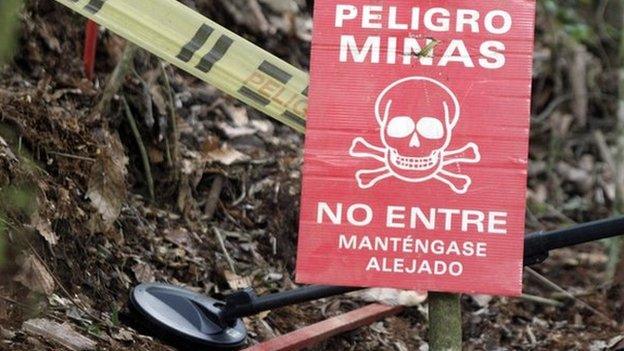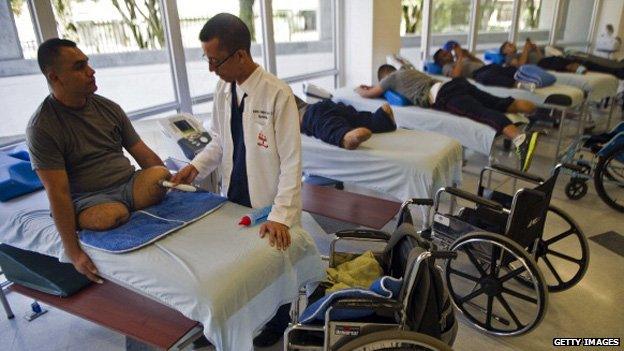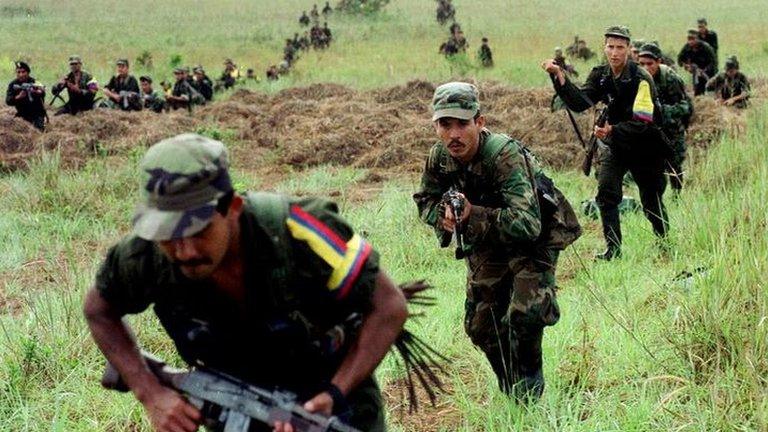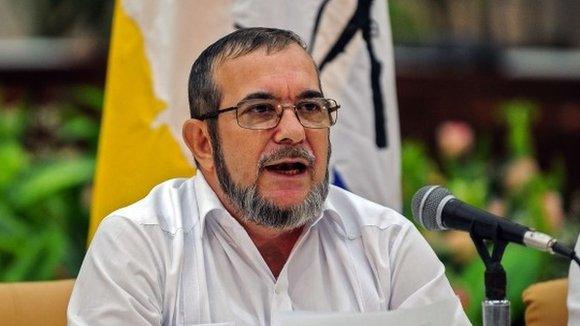Clearing Colombia of landmines
- Published

A historic deal offers hope that the country's landmines could be cleared
More than 11,000 people have been killed or maimed by landmines in Colombia over the past 25 years.
Only Afghanistan has higher numbers of landmine victims, Colombian government figures suggest.
Many of the mines have been planted by Colombia's largest guerrilla group, the Revolutionary Armed Forces of Colombia (Farc), during the 50-year armed conflict with the government.
As part of peace negotiations currently under way in Cuba, the Farc recently agreed to work with the Colombian security forces to clear the mines.
Risky task
The guerrilla group says it will identify the locations of mines they planted so that specialised army unit, of which there are 2,100, can remove them.

It can take Sgt Beltran's troops a day to clear just one mine.

Sergeant Beltran: "Your first mistake when dealing with explosives is also your last one"
It is a highly dangerous and complicated task, explains Sgt Martinez Beltran, who has worked in mine clearance for 17 years.
"Your first mistake when dealing with explosives is also your last one," he says.
Slow progress
The unit of four soldiers he commands can spend a whole day removing just one mine - or up to 12 on good day.
They first try to spot trip wires and other possible triggers.
One soldier then repeatedly throws into the minefield a heavy weight made from special explosive-resistant material. The weight is attached to a 70m-long (230ft) rope and as he pulls it back, it detonates any mine it comes across.
A specially trained dog and its handler then go into the field to identify explosive substances that cannot be found with a metal detector.
"There's no risk for the dog because we check for trip wires beforehand," Sgt Alvaro Martinez Beltran explains.
Two soldiers then check the terrain with a metal detector. Any unexploded devices are then detonated by the sergeant.
Hunting for mines
The soldiers are well trained and highly skilled, but locating a minefield in Colombia's varied terrain, which ranges from dense jungle to high mountains is no easy task.

More than 11,000 people have been injured or killed by landmines in Colombia in the past 25 years
This is where the contribution of the Farc will be key, believes Lt Col David Navia, who commands 120 soldiers that work in mine clearance.
In 2014 his team deactivated 28 minefields, with some 220 explosive devices in them.
"If (the Farc) provide us with the exact location of the mines this whole process will be much faster," he says.
But the new plan is not without its problems.
Many of the Farc explosive experts who knew where the mines had been placed have been killed in combat.
To complicate matters further, many mines have been shifted by heavy rains and will no longer be where they were originally laid.
Decades of work
Oscar Naranjo thinks the country could be cleared of mines within 10 years.
Gen Naranjo is the former chief of the Colombian police and was named Post-conflict Minister last year, in charge of advising the government on the disarmament and demobilisation of the rebels.
But others think he is being too optimistic and it could take up to five decades before Colombia can be declared mine-free.
They point to Nicaragua, a country which is much smaller than Colombia, and which took two decades to clear its territory of mines.
Even if every device planted by the Farc can be found and removed, those laid by Colombia's second-largest guerrilla group will still remain.
The National Liberation Army continues to fight the government and is unlikely to reveal the location of its mines in the near future.
And it is not just the guerrilla groups which have planted explosive devices. It is also a strategy used by the country's many criminal groups to protect their territory.
Clearing the country of mines will also be costly.
According to the director of the NGO Colombian Campaign to Ban Landmines, Alvaro Jimenez Millan, it will cost "many millions of dollars".
Nevertheless Mr Jimenez is still optimistic.
"This agreement is the first one coming out of the [Havana negotiation] table that will mean a real change in the lives of people living in the [highly mined] territories," he says.
- Published7 March 2015

- Published15 December 2010
- Published24 September 2015
